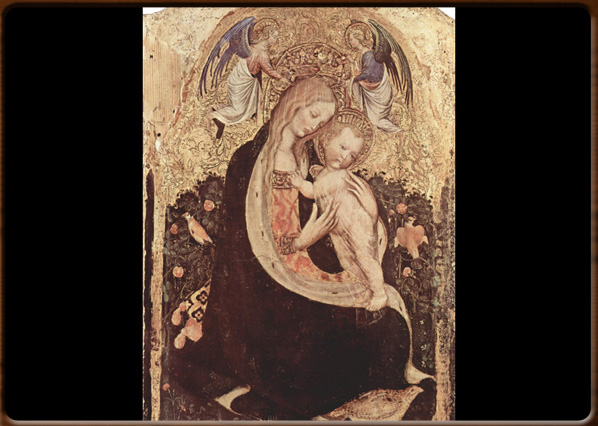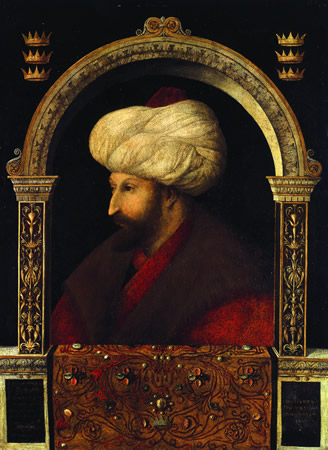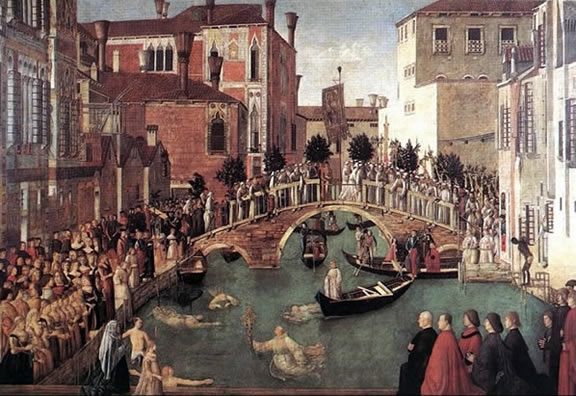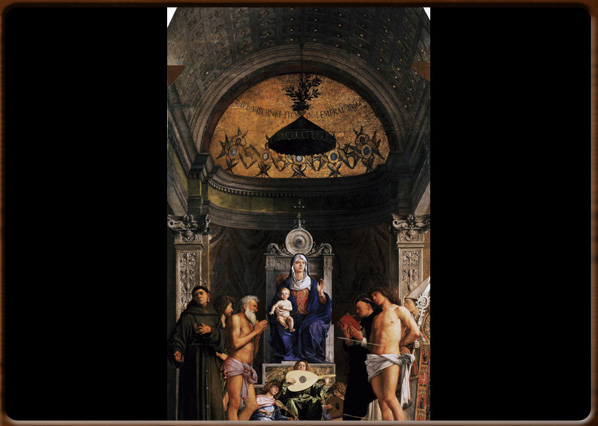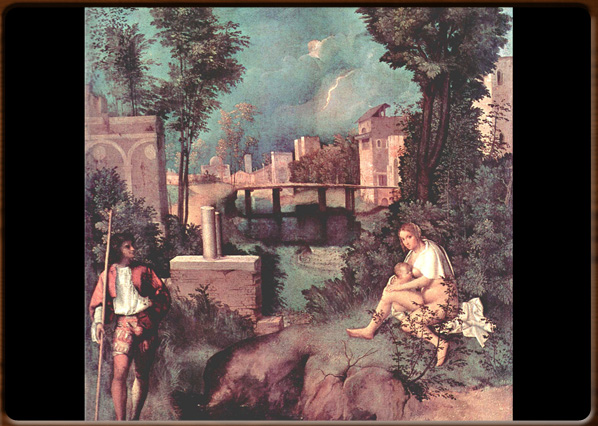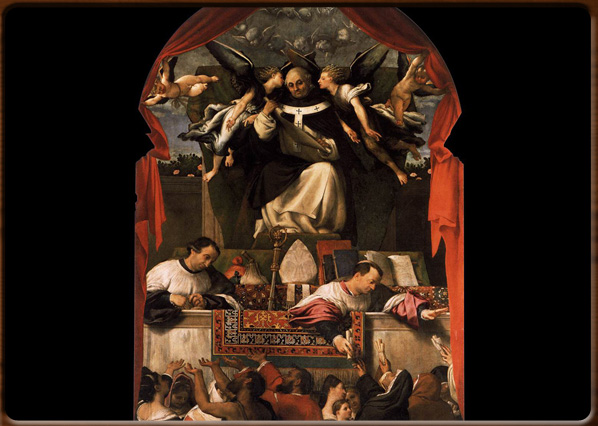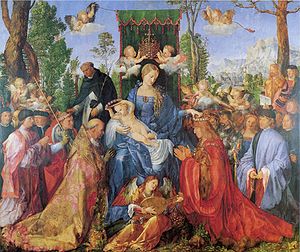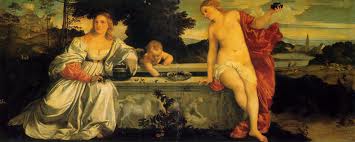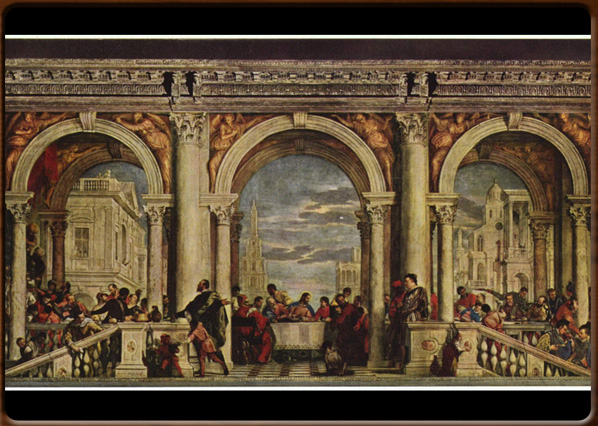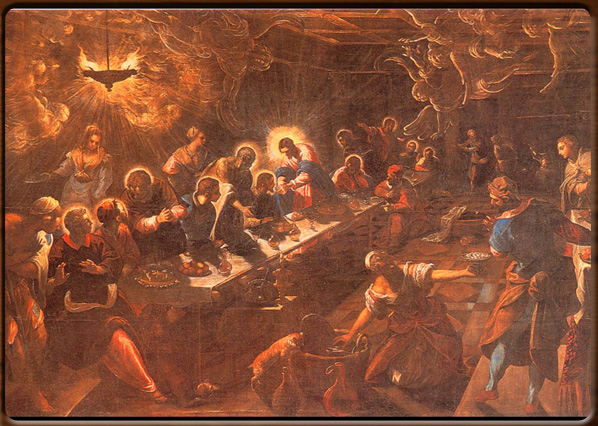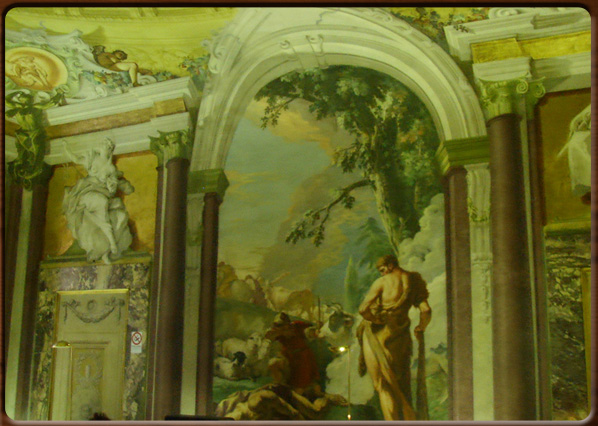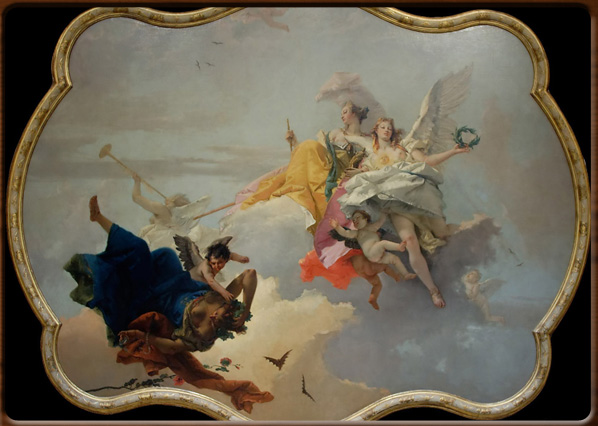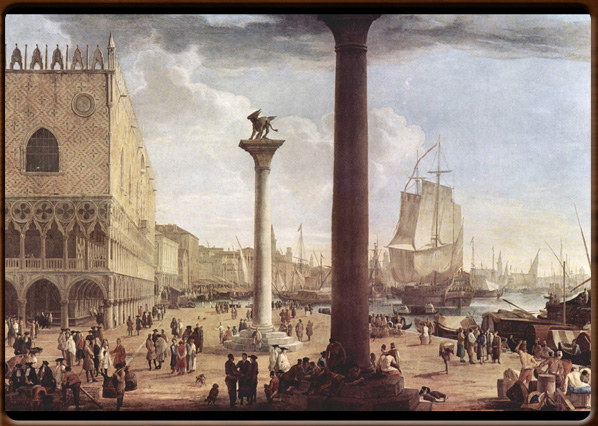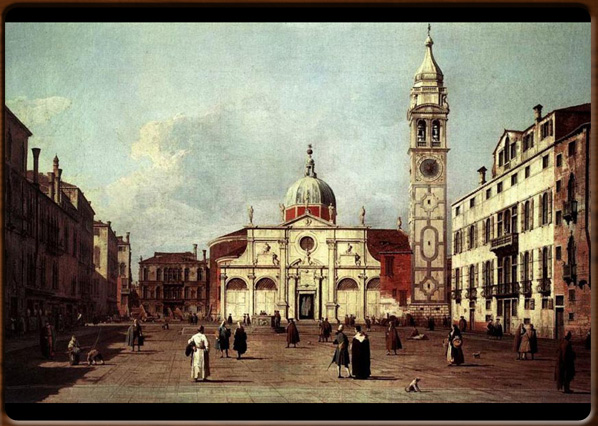Venetian art is distinguished by a merging of traditions, cultures and customs, thanks to the unique civilization of this lagoon city and its wide ranging network of contacts, relationships and links.
Venice is form, material, water, air, fire, light and colour and its art has its roots in these signs of space and time.The first signs of Venetian figurative art can be seen in the oldest monument of Venice: S. Maria Assunta , the Cathedral of Torcello.
The mosaic in the vault of the chapel on the right of the apse, representing the Mystical Lamb supported by four Angels in white frocks can perhaps be dated back to the 9th Century and is similar to that with the same theme in the presbytery of San Vitale in Ravenna. Venice was very much a Byzantine city in the 10th Century: this is reflected in the decoration of St. Mark’s Basilica , one of the masterpieces of all time.
Here it is easy to note the two traditions influencing Venetian art between the 11th and 12th Centuries: the Christian tradition filtered through Ravenna and that of Constantinople and its lands (Chios, Thessaloniki, Dafnì, San Luca in Focile). The mosaic of the "Last Judgement" in the Cathedral of Torcello belongs to this period.
It is thought that Venetian mosaicists went to Porec in Istria 1277 to decorate the Sacrarium of the cathedral there . The master responsible for the Stories of Moses in Poreč influenced Byzantine art, determining the evolution of its lines and volumes.
Today we can still see the results in the magnificent mosaics of San Salvatore in Cora.
On the left of the chapel of San Zan Degolà there are some fine frescoes belonging to the Byzantine school (13th-14th Centuries). Fragments of frescoes still under the Byzantine influence are also found in the Church of the Holy Apostles ("Santi Apostoli").
The first truly Venetian artist who made a name for himself was Paolo Veneziano: he signed and dated the painted icon in the Basilica di Santi Maria e Donato on Murano (1310).
Still very influenced by the Byzantine tradition, he also felt the influence of the mainland 20, the Po Valley. Indeed, Giotto had worked on the Scrovegni Chapel in Padua in 1305. It is believed that Paolo Veneziano travelled to Constantinople. The critics of those days called him the greatest painter of the Byzantine Mediterranean, the last non-Greek and the first of the Venetians.
Gothic painting in Venice was still linked to Byzantine formulas and models in its early days, partly the result of Paolo Veneziano’s work in the first half of the 14th Century. The Venetian school is characterised by a great fantasy in decoration, plus brilliant golds and bright colours. The greatest international Gothic artists in Venice were: Gentile da Fabriano (resident in Venice from 1408 to 1414), Michelino da Besozzo (active between 1410 and 1415) and Antonio Pisanello (he worked on the Doge’s Palace in 1415).
In the 14th Century and for much of the 15th Century, St. Mark’s Basilica retained the formulas of Byzantine art. The paintings by Giovanni d'Alemagna and his brother-in-law Antonio Vivarini in San Giobbe and in S. Pantalon are pure Gothic. The St. Mark’s Museum has some tapestries depicting 10 stories of the Passion, probably of Flemish origin and woven in around 1420 on the basis of sketches by Niccolò di Pietro.
Andrea del Castagno and Paolo Uccello also lived and worked in the lagoon area towards the middle of the 15th Century, but they left no special mark on Venetian painting. Two studios competed for commissions in Venice: that of the Vivarini family and that run by Jacopo Bellini where his children, Gentile Bellini and Giovanni Bellini , learnt their craft.
The arrival of Antonello da Messina in 1476 brought with it the Flemish technique of oil colour, which influenced the members of these two families. In 1479 Gentile Bellini was sent by the Serenissima to Istanbul as court painter in response to the request made by the "Great Turkish" Mohammed II to have a great portrait painter. There he painted the famous portrait of the Sultan that is now hung in the National Gallery in London, together with many other canvasses that have since been lost. The Sultan awarded him with great honours.
Other works by Gentile that still exist today include those in the cycle of the Miracle of the Cross , painted along with Mansueti, Diana, Bastiani and Vittore Carpaccio, and the "Telèri", large canvasses, adorning the Scuola di San Marco, which he painted together with his brother Giovanni.
Giovanni Bellini is hailed as the “Patriarch” of Venetian painting. His masterpieces, the result of a long career, still adorn Venice. These include the altarpieces in the churches of Santa Maria Gloriosa dei Frari, San Giobbe , San Zaccaria and San Giovanni Crisostomo. The new approach introduced by Bellini can be seen in the facelift of the city at the end of the 1400s and early 1500.
Carpaccio was inspired by his city. In his Miracle of the Cross at Rialto , he depicts Venice with great attention and sensitivity to the use of light and the details of a bustling crowd on the banks and the gondolas. An African gondolier stands out in his elegant livery, while a melancholy white dog watches the show. Also by Carpaccio are the painted rugs in the Legend of St. Ursula (now in the Gallerie dell’Accademia): made in Spain, they are of Turkish inspiration and were brought to Venice by Jewish refugees driven out of Spain after 1492.
In the last days of his life, Carpaccio continued to receive commissions from Istria and Dalmatia.
The great Leonardo da Vinci arrived in Venice in 1500 and clearly influenced local painting, as can be seen in the works by Giorgione of Castelfranco. Another influence on his style was Hieronimus Bosch from S. Hertogenbosch (Holland).
Giorgione upset the artistic balance of the 15th Century by adopting different chromatics and sensitivity .
Albrecht Dürer of Nuremberg visited Venice on two different occasions: in 1494 and in 1505-1506. He influenced Giorgione and other painters, such as Lorenzo Lotto.
An example of this cultural melting-pot is the Sant’Antonino altarpiece by Lorenzo Lotto in the Basilica dei Santi Giovanni e Paolo , a painted Turkish rug. Dürer left Venice with a magnificent Feast of the Rosary, painted for the Chiesa di San Bartolomeo and now preserved in Prague. The altarpiece in the church was replaced by a work by Johann Rottenhammer (Munich) representing the Annunciation with the Eternal and Angels.
Titian learnt his craft in the Bellini school. Alongside Giorgione he was the leading artist of the 1500s in Venice.
The inspiration during his long career was the search for beauty and harmony of figures, colour and light. In the final stages of his life he would achieve absolute and extreme levels of perfection. He painted portraits of all the most important people of his time: the Emperor Charles V of Hapsburg, King Francis I of France and the Sultan Suleiman the Magnificent.
Other major painters in the 16th Century were Paolo Veronese , the Bassano family and Jacopo Comin (also said "Robusti" or "Tintoretto").
The Croatian Andrea Medulič (Schiavone) worked with Tintoretto on the frescoes that adorned the facade of Palazzo Zen ai Gesuiti. Other works by Schiavone can be seen in the Salone della Libreria at St. Mark’s.
Two artists following Titian’s tradition began their careers in Venice: his pupil Lambert Sustris of Amsterdam and the great Dominikos Theotokopulos ("El Greco") , originally from Crete and the heir of a tradition of Cretan-Venetian "madonneri" painters working in Venice for the Greek community .
These included Michele Damaskinos and Giorgio Klonzas of Crete and Emanuele Lambardos and Emanuele Zanfurnaris of Greece.
Greek painters continued to work in Venice in the 17th Century: Emanuele Zane from Candia, Theodoros Pulakis from Crete and Vittore from Corfu.
Paolo Fiammingo stopped in Venice in 1589 and Lodewijk Toeput (Pozzoserrato) lived in Venice from 1582 onwards.
Many other foreign painters found work in the city – Hermann Zerest (Flemish), Jean Le Clerc (Nancy, France), Nicolas Régnier (Maubeuge, France) and Michele Desubleo (also from Maubeuge) – all leaving their mark on Venetian painting.
Gaspar Rem from Antwerp painted canvasses in the former School of Wine Merchants ("Scuola dei Mercanti di Vino") in San Silvestro. Antonio Vassilachi (Aliense), the Greek painter from the island of Milo, worked on the Doge’s Palace, preparing cartoons for the mosaics for the never-ending construction site of St. Mark’s Basilica.
The Flemish Johann Liss is one of the precursors Venetian eighteenth century art: his masterpiece is the luminous vision of San Gerolamo in San Nicolò dei Tolentini, ahead of Giambattista Tiepolo . Carl Loth (Munich) also painted many works in the churches of Venice.
The final and most triumphant age of Venetian painting saw its painters travelling throughout Europe. Sebastiano Ricci of Belluno left his mark in Austria, England and France, where he was accepted as a member of the Académie Royale de Peinture et de Sculpture in Paris on account of his fame and talent.
Like Sebastiano Ricci , also Gian Antonio Pellegrini travelled around Europe, staying in various locations. Pellegrini’s model clearly influenced the art of Gian Antonio Guardi and Rosalba Carriera . The latter, a fine portrait painter, met the great Watteau during one trip to Paris in the company of Pellegrini. Rosalba Carriera stayed for long periods in Paris and Vienna, during which time she had the chance to meet with and exchange ideas with many pastel artists and portrait artists.
Frederick Bencovich (believed to have been born in Venice) had a major influence on Rococò artists in Austria, where he worked in Vienna for over 10 years.
Jacopo Amigoni painted the frescoes in the castles of Nymphenburg and Schleissheim in Bavaria, then worked in England and in Madrid, where he died in 1752.
Another important Venetian painter was Piazzetta: his masterpiece is the Assumption now in the Louvre, painted for the Elector of Saxony.
Tiepolo was the most important Venetian painter in the 18th Century. At the height of his career (1750-1753), he was called to Würzburg in Germany together with his sons Giandomenico and Lorenzo to paint the residence of the Prince-Bishop.
After returning to Venice, he was plied with commissions until 1762, when he accepted an invitation from the Spanish court to decorate the royal palace in Madrid.
After completing this, he started work on the altarpieces of Aranjuez.
Giambattista Tiepolo died in Madrid.
Francisco Goya later developed his legacy of captivating colour.
The 18th Century was the age of the landscape artists: Carlevarijs , Canaletto, Bellotto, Marieschi and Francesco Guardi being the greatest exponents.
Antonio Canal (said "Canaletto") captures the effects of perspective and chromatic poetry in his paintings: he worked for the art collector and Consul of Great Britain, Joseph Smith, with whom he had a running agreement whereby he stayed in England in 1746 - 1756.
Bernardo Bellotto , Canaletto’s nephew, started his career in the footsteps of his uncle, but more natural effects could later be seen in his works.
In 1747 he went to Dresden where for ten years he was established at the court of Augustus III, Elector of Saxony and King of Poland. He lived in Warsaw from 1763 to 1780, creating some extraordinary views of the city. These views made it possible to reconstruct the city after its destruction during the Second World War.
The last major landscape painter, Francesco Guardi , ends the great age of Venetian painting.
Michelangelo Mandich





